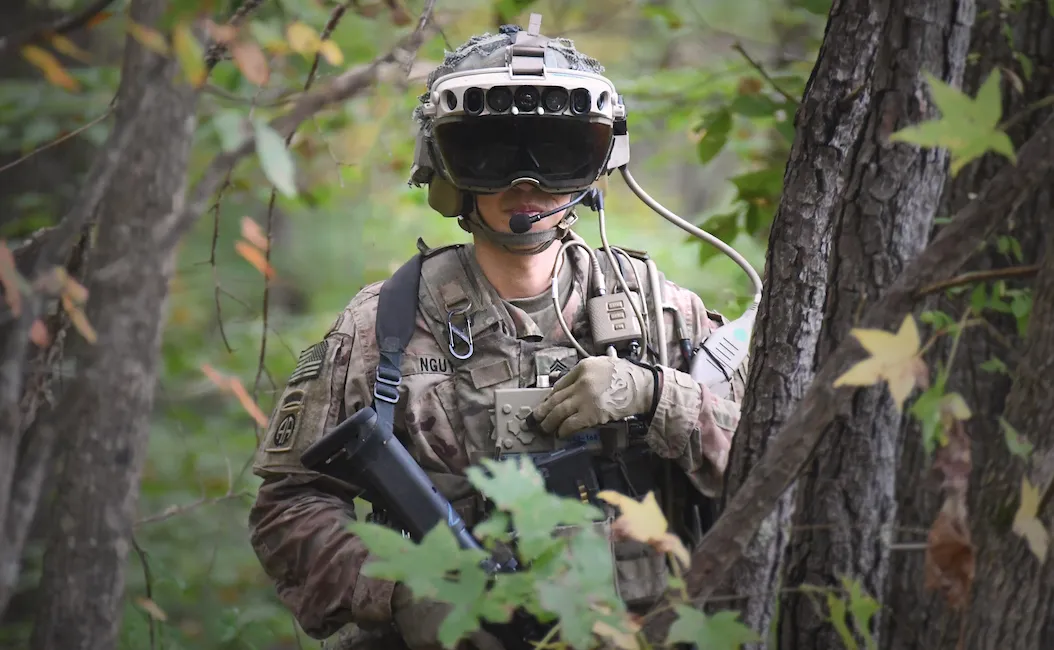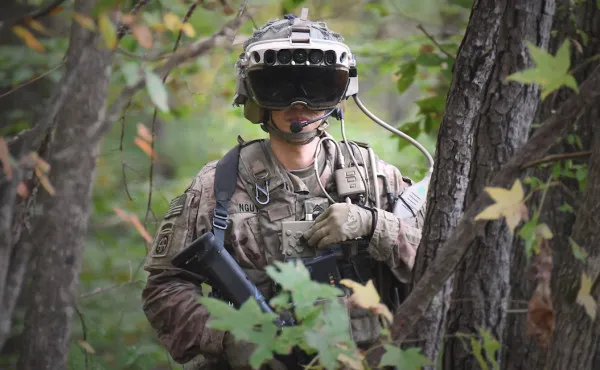

The U.S. Army’s augmented reality headset is slowly but surely transitioning from delicate high-tech novelty to reinforced, ruggedized battlefield asset ahead of its eventual fielding to soldiers starting in 2021.
Soldiers from the 82nd Airborne Division and a handful of Marines were the latest American service members to test out the much-hyped Integrated Visual Augmentation System (IVAS) during a major testing and demonstration event held at Fort Pickett in late October.
The test was the third major ‘soldier touchpoint’ administered by Army Futures Command’s Soldier Lethality Cross-Functional Team to elicit soldier feedback and help refine the advanced system for eventual battlefield use.
While previous soldier touchpoints employed a commercial version of the Microsoft HoloLens on which the IVAS system is based that couldn’t even stand up to inclement weather, the third touchpoint put a ruggedized version of the headset through a series of company-size training events.

The IVAS capabilities the Army put to the test include a digital display to access information without taking eyes off the battlefield, thermal and low-light sensors, rapid target acquisition, and aided target identification. In addition, the headset’s augmented reality “fight-rehearse-train” system, which incorporates real-time mapping, is endlessly applicable for training and rehearsing operations “anywhere at any time,” as the Army previously put it.
The training events included land navigation, live fire, mission planning, rapid target acquisition, trench clearing, and even an after-action review using the headset’s augmented reality capabilities, according to the Army.
By the end of this event, Army officials will have 40,000 hours of soldier data on the ins and outs of how the IVAS actually fares in the field, Brig. Gen. Tony Potts, the director of PEO Soldier, said in a statement.
“If we want to develop systems at the speed of relevance and systems that our Soldiers want to use, this is the way we have to do it,” Potts said. “We have learned so much through Soldier Centered Design. Our real desire is to let Soldiers design it, and then our engineers build what they design. It’s about listening to our Soldiers.”

The third soldier touchpoint represents a major leap forward for the IVAS after nearly two years in development “to regain and maintain overmatch in multi-domain operations on battlefields that are increasingly urban, congested, dark and unpredictable,” as the Army previously put it.
“Overmatch has always been defined in terms of two things; our lethality and our protection must exceed the lethality and protection of our adversaries,” Brig. Gen. David Hodne said of the IVAS on Oct. 30, according to the Army. “In order to restore overmatch, we must restore lethality, and lethality means we can see, designate, and move quickly through hours of limited visibility.”
While the Army’s new ruggedized IVAS goggles represent a major improvement over the delicate commercial HoloLens, the headset still has one more technological metamorphosis ahead of it: According to the Defense Department’s chief operational testing authority, the upcoming IVAS Capability Set 4 “will be the production-ready end-user device to provide enhanced squad lethality.”
The Army plans on fielding more than 40,000 IVAS goggles to soldiers by late fiscal year 2021, according to the service’s budget request released in February. And hey, if Army Chief of Staff Gen. James McConville can rock it, so can you:
Related: The Army’s next-generation headset is still on schedule to get to soldiers by 2021 — for now
